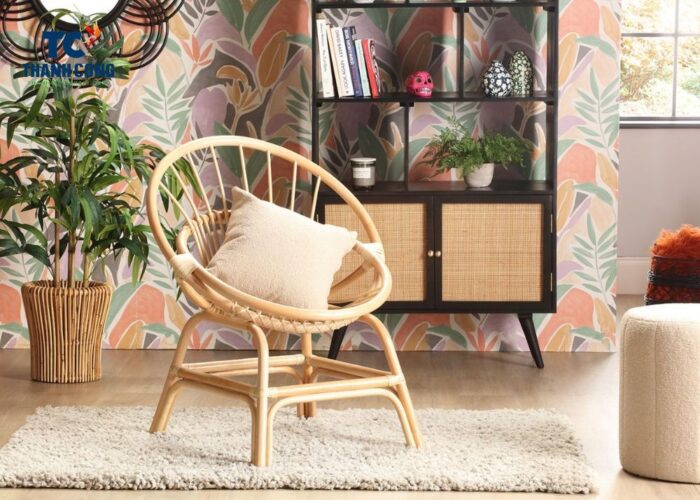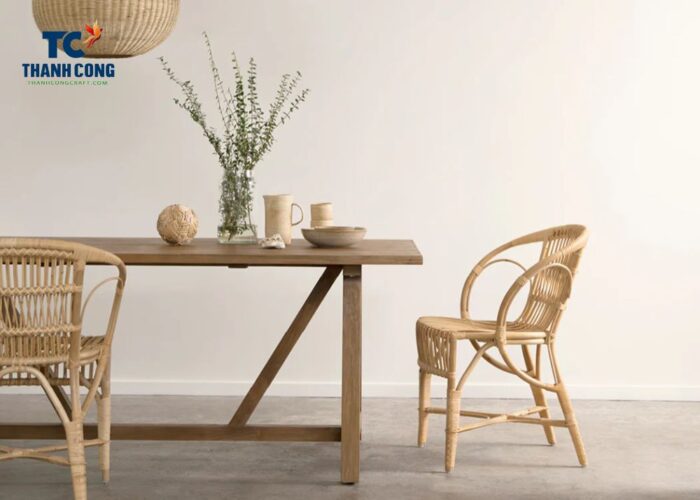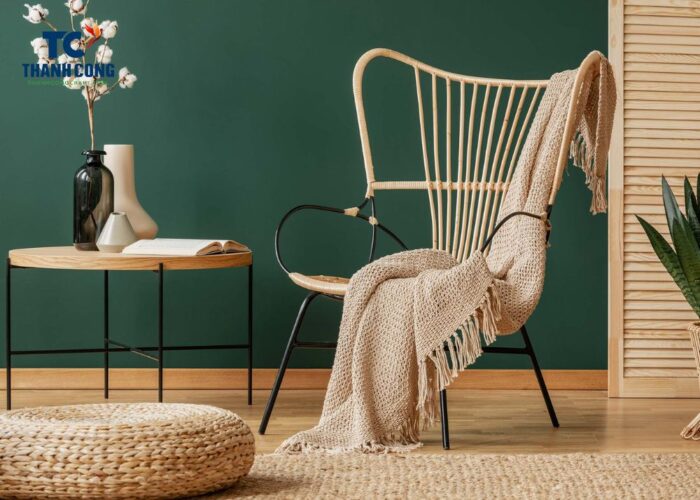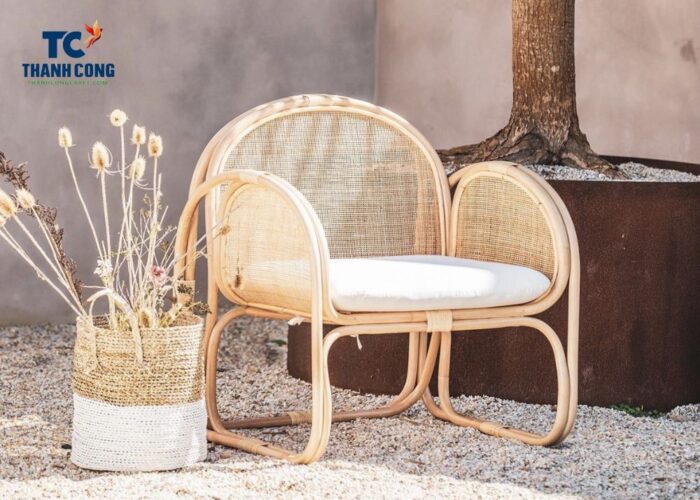Woven rattan, often admired for its natural elegance and intricate craftsmanship, comes with a price tag that might raise eyebrows. The question arises: Why is rattan so expensive? To unravel this puzzle, we need to delve into various factors that contribute to the elevated cost of rattan furniture and products.
Contents
1. What is rattan made of?
Rattan is made from the stems of climbing palms belonging to the genus Calamus. Let’s delve into the most detailed understanding of the components of the rattan plant!
- Stem rattan: The stem of the bamboo plant is not only visually appealing but also remarkably flexible, making it easy to bend and work with. The underground stem, often dark in color, lies close to the ground. The above-ground stem segments develop into clusters, each with multiple stems emerging from the underground stem. The vital stem can have a diameter ranging from 0.8cm to 1.2cm, varying with soil conditions and climate. It can reach lengths of up to 30 meters or even more. Encased in layers of green leaf sheaths, it also boasts sharp thorns, making it a preferred choice for constructing protective fences. The stem is divided into numerous segments, each around 15 to 40cm long.

- Roots:The roots of the bamboo plant are robust and capable of firmly anchoring into the soil. With rapid growth, bamboo roots readily adapt to various living conditions. The root’s outer layer is tough, while the inner core is sturdy. The roots tend to form surface protrusions as they develop. For mature or large underground-stemmed bamboo plants, the root system can be substantial.
- Leaves: Bamboo leaves are single and resemble bird feathers. Fully grown leaves can extend up to a meter, organized into clusters of 2 to 4 leaves each. On average, leaf blades are about 30cm long and 2 to 3 cm wide.
- Flowers: Bamboo plants produce flowers in clusters, usually in May and June each year. Unique to bamboo, the flower spikes prominently develop at the tip. Each flower cluster contains multiple smaller flower clusters, bearing fragrant, distinctively scented yellow flowers.
- Fruits: Bamboo fruits typically appear around 4 to 5 years after planting and care. The fruit is small in comparison to the stem, with a diameter of approximately 0.6cm and a spherical shape. The fruit’s surface features layered, large scales. A mature bamboo plant can bear around 5000 fruits, each containing a single seed.
2. Why is rattan so popular?
Rattan, a natural material derived from the stems of climbing palms, has garnered immense popularity in various industries, including furniture, home decor, and fashion. Its widespread appeal can be attributed to several key factors that contribute to its popularity:
- Natural Aesthetic: Rattan’s distinct natural texture and warm color lend a timeless and organic feel to any space. It adds a touch of nature indoors, creating a harmonious connection between the indoor and outdoor environments.
- Versatility: Rattan’s versatility is a significant factor in its popularity. It can be woven into intricate patterns and shapes, making it suitable for a wide range of products, from furniture to baskets, lighting fixtures, and even fashion accessories.

- Durability: Rattan’s inherent strength and durability make it well-suited for everyday use. It can withstand wear and tear, making it a reliable choice for furniture and home items that need to endure regular use.
- Lightweight and Sturdy: Despite its sturdy nature, rattan remains lightweight, making it easy to move and rearrange. This characteristic is particularly valuable for furniture pieces that might need to be shifted frequently.
- Eco-Friendly Choice: With growing awareness about sustainability, rattan’s renewable and natural properties have elevated its popularity. Being a fast-growing plant, it is considered a more environmentally friendly alternative to traditional wood. Therefore, rattan products such as rattan coffee table, rattan cabinet and rattan shelf are loved.
3. Why is rattan so expensive?
Rattan, a natural material derived from the stems of climbing palms, has garnered immense popularity in various industries, including furniture, home decor, and fashion. Its widespread appeal can be attributed to several key factors that contribute to its popularity:
- Labor-Intensive Craftsmanship: The process of weaving rattan is intricate and time-consuming. Skilled artisans spend hours meticulously crafting each piece, often using traditional techniques passed down through generations. The labor-intensive nature of this craftsmanship translates to higher production costs.
- Natural Material Sourcing: Rattan is sourced from climbing palms and undergoes a rigorous process to transform it into the pliable material used in weaving. Harvesting rattan sustainably, treating it, and preparing it for weaving involves careful attention and resources, which can add to the overall cost.
- Limited Availability: Rattan is a natural resource that requires specific growing conditions. It is primarily found in tropical regions. The limited geographical distribution can impact the availability of quality rattan, potentially leading to higher prices due to supply and demand dynamics.
- Skilled Artisans: Crafting intricate pieces from rattan requires skill and expertise. Skilled artisans who possess the knowledge of traditional weaving techniques are essential to create high-quality rattan products. Their craftsmanship commands fair compensation.

- Durability and Longevity: Rattan furniture is known for its durability and longevity, often lasting for decades with proper care. This extended lifespan justifies a higher initial investment, as consumers can enjoy the product for a significantly longer period.
- Design and Aesthetics: Woven rattan is not only functional but also highly valued for its aesthetic appeal. Many rattan products are carefully designed, often blending modern trends with traditional craftsmanship. The design effort can contribute to the final cost.
- Eco-Friendly Choice: With growing awareness about sustainability, rattan’s renewable and natural properties have elevated its popularity. Being a fast-growing plant, it is considered a more environmentally friendly alternative to traditional wood.
- Adaptable to Styles: Rattan effortlessly adapts to different design styles. It complements bohemian, coastal, Scandinavian, tropical, and even minimalist aesthetics, making it a versatile choice for various decor preferences.
- Affordability: Rattan products often offer a more cost-effective alternative to solid wood or metal counterparts while maintaining a high-quality appearance and functionality.
Is rattan furniture worth it?
Elegance of Rattan Furniture: The reason why rattan furniture becomes the focal point of customers is its elegant appearance. With the sophisticated and trendy rattan structure, it is easy to see that the product will never go out of style. The design brings a subtle elegance to any space that you want to decorate. It is a combination of the rustic beauty and the modern minimalist style. In addition, some rattan furniture products also have soft cushions, which will give you a comfortable and gentle feeling when using and that is also a highlight that contributes to the beauty of the rattan products such as rattan tables and chairs, rattan sofa.
Durability of Rattan Furniture: Because the product is made entirely from 100% natural rattan, it is considered a material with high durability. Besides, it is also meticulously processed by skilled artisans through many stages from selection to treatment, so it has a long lifespan. However, the quality of the product also depends a lot on how to use, preserve and clean it and also on the place of purchase.

Weight of Rattan Furniture: Rattan furniture has a lighter weight than other furniture materials. Therefore, you can move it to any position easily.
Ideal for Your Space: Rattan furniture is definitely the best product for your home or shop space. Many individuals are currently choosing rattan furniture products to refresh the appearance of their homes. With different colors, it will create a harmonious, peaceful and timeless beauty. The durable and beautiful rattan brings warmth and relaxation to the space.
Rattan Furniture is Environmentally Friendly: Natural rattan furniture brings many benefits for the living environment, including its decomposition. Because it is a natural rattan, it is very friendly and close to the environment and also safe for users. Easy decomposition in a short time is also a way to protect the environment.
The above article is the answer for the question why is rattan so expensive and others, If you have any further questions, please don’t hesitate to leave Thanhcongcraft an email at [email protected] or Tel/WhatsApp: +84967485411. Hope to serve you soon! Best regard!


